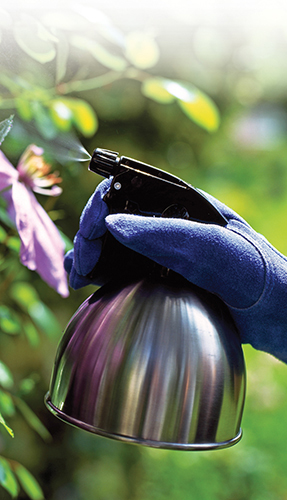
Using chemicals to combat plant diseases has become the norm. However, many gardeners are now returning to tried-and-trusted traditional methods to counteract pests and keep plants healthy.
Certain chemicals used in fertilizers and pest controls have now been banned. Fortunately, nature can help combat many garden diseases.
Fungus in garden plants is often weather-related. Extremely damp or dry weather can encourage fungal growth. In addition, viruses, bacteria, and nutrient deficiency or overabundance can cause health issues.
• Avoid overfertilizing. Fortify plants with slurries (see “Feeding and revitalizing”).
• To prevent disease, consider location and observe the rules of mixed cultivation and crop rotation.
APPLY HERBAL SPRAYS in the evening OR ON OVERCAST days.
GOOD TO KNOW 
Disposal is the only cure
Phytophthora is a fungus that destroys a plant’s root system, preventing it from taking in water and nutrients. Leaves may develop brown patches at the tips and edges, then yellow, dry out and die. Limit the spread of the disease by disposing of the plant, including roots, and don’t replant in the same hole. Practice good garden hygiene by keeping tools, machinery and boots clean.
In this metabolic disorder, the plant doesn’t produce enough chlorophyll so leaves or plant parts turn yellow and it withers. This occurs as a result of too much lime in the soil, dense soil or waterlogging. Raspberries, hydrangeas, roses, pelargoniums and rhododendrons are most likely to be affected.
• Water plants with rainwater or douse them occasionally with a nettle slurry (see here).
• If chlorosis is already present, loosen up the soil and improve it by working in plenty of compost.
This fungal disease—subdivided into powdery mildew and downy mildew—is a common problem. It is characterized by a white or gray fungal growth.
• Powdery mildew is a threat to apples, apricots, peas, strawberries, cucumbers, peaches, delphiniums, roses, crepe myrtle and grapevines. It is prevalent in hot, dry conditions and appears as a whitish, floury layer.
• Downy mildew attacks strawberries, peas, lamb’s lettuce, cabbage, lettuce, horseradish, radish, salsify, spinach and onions. It sets in during damp weather or in a moist greenhouse and spreads quickly. You will notice light spots on the top of the leaves and a grayish coating on the underside.
• Prevent both by purchasing mildew-resistant strains. Choose a sunny location to grow them and space the plants out well. Plant garlic between them or spray with a solution of 1 teaspoon (5 ml) baking soda in 1 quart (1 L) water.
• For a powdery mildew infestation, cut off sick leaves, shoots and branch tips; compost them.
• Spray every 2–3 weeks in spring and summer with garlic spray. Chop one or two garlic bulbs; cover with boiling water in a lidded jar. Soak overnight, strain and mix with 1 quart (1 L) diluted soap solution.
• To prevent or control downy mildew in seedlings, steep 11/2 teaspoons (7 ml) dried chamomile flowers in 1 quart (1 L) boiling water. Cool the infusion and spray it on the seedlings.
• If plant parts are affected, remove the entire plant.
A fungal disease, it attacks fruit and vegetables such as strawberries, peppers, lettuce, tomatoes and grapevines. Ornamental plants can also be affected.
• Afflicted produce develops a grayish-white fungus and may rot and die.
• Space plants out well and prune to ensure good air circulation as prevention.
• Place straw underneath strawberry plants to keep the fruit from lying on the ground.
• If botrytis has gained a foothold, remove diseased plants and burn or bury them away from healthy ones.
This fungal disease takes hold on trees and wood, as well as on stone fruit, especially peaches and plums. Infections on wood and flowers tend to occur when there is prolonged wet weather during flowering. Fruit rot occurs when the skin of the fruit is damaged.
• Blossom and twig blight occurs frequently with apricots, cherries, peaches and plums. The blossoms wither and the shoots die from the tip back. Affected leaves don’t fall off.
• Fruit rot is characterized by small, squishy brown spots that rapidly grow in size until the whole fruit is rotten. It especially affects the fruit of apple, cherry and plum trees. The fruit don’t always fall off.
• Prune endangered trees and open up for good ventilation. Fortify with tea made from leaves and roots of horseradish; try garlic spray (see “Mildew”).
• If brown rot is present, discard all diseased fruit on both the tree and the ground, and toss or burn. Cut back diseased branches to the healthy wood.
• Spray with an organic fungicide such as Bordeaux mixture or lime sulfur in autumn as the leaves fall, and again at bud-swell. Apply a copper-based fungicide as flowers open and as the petals fall, then again a month and 2 weeks before harvesting fruit.
A fungal infection, it appears on leaves and stems. Rust species tend to be host specific (for example, beans, leeks or asparagus), although some do change host plants. They spread by tiny spores and grow best in humid, moist environments.
• Orange or red pustules appear on the underside of leaves, as well as yellowish-red spots on the tops.
• For prevention, plant in a sunny, well-ventilated area and loosen the soil frequently.
• Remove diseased leaves immediately and add them to the compost pile.
• Garlic spray is also a good treatment for rust.
Moss extract for powdery mildew
About 2 ounces (50 g) dried moss
1 quart (1 L) water
Shred the moss and soak in the water for 24 hours. Strain it and put the solution in a spray bottle. Spray every couple of weeks to prevent powdery mildew. In case of infection, spray every couple of days. Sphagnum moss is the most effective moss, but you can try using lawn moss—a good way of getting rid of it.